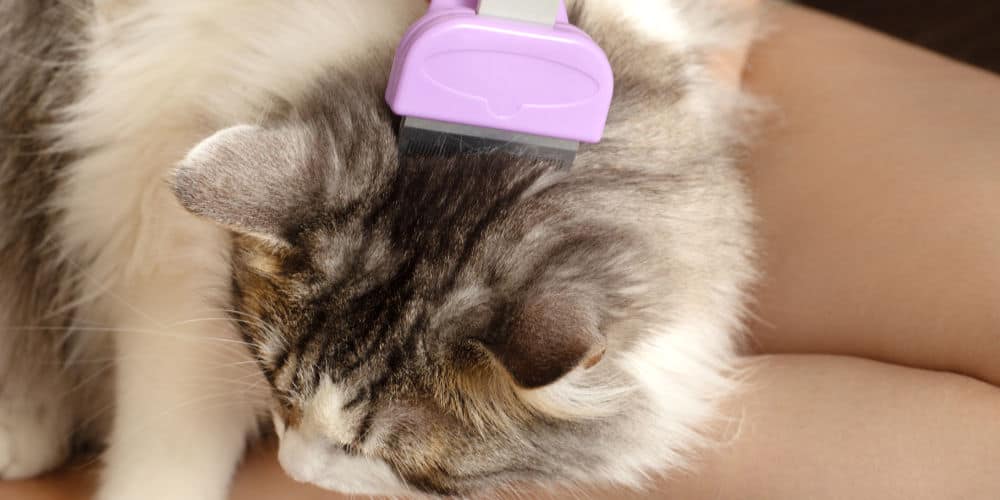How to Groom a Cat Peacefully

Cats are clean pets and are very fond of grooming themselves. Your feline baby will most likely clean its fur repeatedly. But if your furry baby has fleas, long fur, or suffers from a medical problem, it will need your help.
When it comes to clipping the claws or bathing your cat after it soils itself, you need to know how to groom a cat without hurting it or triggering it. So keep on reading to learn about taking care of your cat’s hygiene needs.
Cat Attitudes is reader-supported. When you buy through links on our site, we may earn an affiliate commission.
How to Groom a Cat
In most cases, cats know how to groom themselves. They clean their fur and avoid getting soiled, but as a cat owner, you will have to give your furry baby a hand to help it clean itself.
If you have a kitten, a pregnant, or a sick cat, you need to know how to groom and handle your cat properly so you don’t hurt it or traumatize it.
Maintaining the Coat
Depending on your cat’s fur, you might need to groom it frequently or less frequently. Short fur requires less maintenance, but regular brushing and combing will help get rid of the trapped dirt, grease, dead skin, and dead hair.
At the same time, scratching the cat’s body while brushing its fur can put it in a good mood. Grooming the cat’s body will also help strengthen the bond between you as the cat knows that you’re taking care of it. This is why you need to be careful about a few things when you’re combing or brushing the fur.
Comb or brush your cat’s fur at least twice a week to help distribute the natural oils that keep the coat glowing. Regular brushing will also get rid of the dead hair that causes tangles and knots. Comb the fur more often if your cat has long fur.
Use a metal comb or a rubber brush. It will help remove tangles and knots without cutting the cat’s fur.
Don’t hold your cat too tight while combing its fur. Cats don’t like to feel trapped or restrained, so it’s best to try to comb or brush the hair while it’s sleeping or sitting in your lap.
Use a gentle motion while brushing the cat’s fur. Aggressive actions can trigger or even hurt your cat.
Take a look at your cat’s fur to see if it needs trimming. Long fur can cause knots and lead to health problems if you don’t take care of it. If you don’t feel like you’re able to trim your cat’s fur properly, you might need to contact a professional groomer.
If you’re using clippers to trim the hair, avoid repetitive motion and take frequent breaks to avoid burning the cat’s sensitive skin. Be extra careful while trimming the hair around the anus, genitals, and eyes. You should apply gentle pressure and leave about an inch of hair while cutting it short.
Giving Your Cat a Bath
Cats aren’t very fond of water, and in most cases, you don’t need to give them regular baths. However, a bath becomes a must if your cat has soiled itself or a doctor has asked you to bathe the cat after administering a specific medication.
Bathing the cat can be a triggering experience for both of you. Although the cat’s tongue is built to clean it properly, sometimes your feline baby needs help with grooming itself if it gets into something sticky like mud. However, you need to follow several steps to make this process for both of you.
Pick the right time to give your feline a bath. If your cat is sick or has been fighting with another cat in the house, it might be a good idea to wait. When the cat is mellow, you can start by brushing its body and stroking it. You can also add some cotton to the cat’s ears, as this will help calm it down.
Invest in the right tools. Placing a rubber bath mat will stabilize your cat and make it feel more comfortable. This will minimize your chance of getting scratched by a frightened cat.
Cats get overwhelmed easily; this is why you need to be careful about the amount of water you use in the bath. Use lukewarm water and only fill the bathtub or sink with about 3 or 4 inches of water. You can use a pitcher or a cup to wet your cat’s body.
Check the cat’s body for any lumps or lesions. Always contact the vet if you see any skin infection.
Avoid using a regular shampoo to wash your cat’s fur. Instead, pick a hypoallergenic cat shampoo to keep the coat in perfect condition. Use only one part of the shampoo with five parts of water and massage the coat in the direction of fur growth. Avoid getting the shampoo into the cat’s eyes and ears.
Rinse the cat’s body gently. Avoid using the pitcher or cup to pour too much water over the cat’s body, as this can be overwhelming. Rinse off the shampoo completely and wipe the face and ears with a moist washcloth.
Use a soft, warm towel to wrap the cat’s body, and use a hairdryer on the lowest setting to dry the fur. If your cat isn’t used to it, it might feel traumatized by the sound.
Always be gentle when you’re bathing your cat. Cats can be extremely triggered, so you need to reward your kitty after a bath.
If you can’t manage to bathe your cat, think about hiring a professional groomer. A professional groomer will know how to handle a stressed cat.
Clipping the Claws
Clipping the cat’s claws or nails is never an easy experience, even if you have had the cat for years. However, with patience and training, you can make the process easier.
If you have a traumatized cat, you need to be more patient. Although you can always take the cat to the vet or a professional groomer to have its nails trimmed, you can do this at home if you follow the right steps.
It’s best to try trimming your cat’s nails when it’s mellow and peaceful. After a meal, your cat can feel sleepy, and this might be a good time to approach it, trying to trim the nails.
If you have multiple cats in the house, take your cat to a quiet and private location. Other pets can distract your cat or even feel too stressed watching another feline having its nails trimmed.
Make sure that your cat is sitting comfortably. This will reduce the amount of stress and can help you get done with the trimming session as soon as possible. You can keep your cat in your lap or choose another position that makes it comfortable and relaxed. Whatever the position you pick, you need to make sure that you’re able to hold the cat’s paws properly to avoid accidents.
Get your feline trained to have its paws touched. Stroking the paws and gently rubbing them will prepare your cat for having the nails cut. When it’s time to cut the nails, rub the cat’s paws for a few seconds until it gets comfortable. Gently squeeze the paw to make the nails extend to get your cat ready.
Choose high-quality nail clippers to make sure that they don’t break the nails or cause any kind of discomfort. Leave the clippers around, so your cat can explore them.
Snap the air using the clippers to get your feline familiar with their sound. You can even cut a straw or a similar object, so your cat doesn’t feel stressed when it hears the cracking noise of the object snapping.
When it’s time to trim the nails, be gentle and act fast. Make sure that you don’t cut the nails too short to avoid harming your cat.
Dealing with Parasites
Fleas, ticks, and mites are common parasites that can easily infect your cat and spread to other pets in the house. Although cats groom themselves regularly, parasites are usually difficult to get rid of. However, fleas and ticks are not impossible to eliminate.
It’s crucial to get rid of fleas as soon as possible as they can make your cat very sick in the long run. Watch out if your cat is itching excessively and check for any lesions. You also need to check the fur for flea dirt or eggs.
When not treated, fleas cause hair loss, skin ulcers, and overall weakening because they feed on the cat’s blood. It’s best to take your cat to the vet so they can prescribe a potent medication to help get rid of the problem.
After treating your cat, you need to treat other pets in the house and clean your house thoroughly. This will help you get rid of hidden fleas and their eggs.
If you have an outside cat, it will most probably have ticks. You need to remove any ticks you find and take your cat to the vet to deal with a serious infestation. Ticks are easy to see, especially when they feed on the cat’s blood.
Put on latex or rubber gloves and use a pair of tweezers to pick the ticks. Discard the ticks in a jar filled with alcohol, then wash the cat’s body with soapy water. Make sure that you’re using a special cat shampoo.
Check your cat for ear mites. They’re highly contagious and are more commonly found in kittens. When not treated, ear mites can cause serious skin and hearing problems. Take your cat to the vet, so they can prescribe proper medication and teach you how to deal with this problem.
Brushing the Teeth
Paying attention to your cat’s oral health is crucial. Dental problems are common in felines because some owners don’t pay enough attention to their cats’ teeth. This is why you need to brush their teeth regularly and use the right tools to keep the cat’s teeth healthy and sharp.
Make sure that your vet checks the cat’s teeth and gum regularly. They will be able to detect and deal with a problem before it gets too serious.
Check the cat’s gums regularly. Gums should be pink and firm. If you feel that the gum is swollen, take your kitty to the vet.
Cats’ teeth should be clean and free of spots or tartar. Make sure that teeth are not moving or broken.
Use a special cats’ toothbrush and toothpaste to brush their teeth daily. Some people also use cotton swabs. Always touch the cat’s face gently and give it time until it gets used to having their teeth brushed.
If you notice a strong oral odor, take your cat to the vet, as this might be an indication that your cat is suffering from gingivitis or a digestive problem.
Final Thoughts
As a responsible cat owner, you need to learn how to groom and take care of your feline. Always be gentle and give your cat time before touching it. Before you know it, your kitty will be looking forward to grooming sessions as much as you do.
